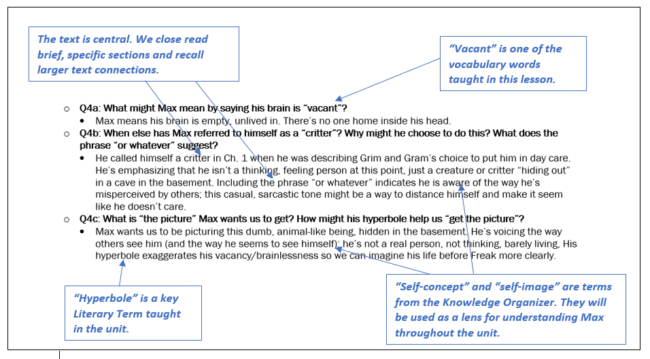03.08.21Notes from Behind the Curtain: One Part of How We Are Developing our Reading Curriculum

As many readers of this blog know, we are hard at work developing a middle grades reading curriculum. It’s built around a diverse array of great books and is designed to implement research on the importance of intentionally building background knowledge, as well as to develop fluency with complex texts and increase opportunities for students to think in writing. Beth Verrilli has been a key part of the process and she offered this glimpse at how we use Stack Audits to constantly examine, refine and improve our materials.
We thought you might like a peek behind the curtain of a Curriculum Team meeting to get sense for how we use feedback and review to constantly improve the Reading Reconsidered curriculum.
Recently, for example, we held a “stack audit” to reflect on our lesson plans.
We find stack audits powerful—the general idea is to gather a group of people and a group of similar products (in schools, that might be Do Nows or Exit Tickets or homework assignments). For our purposes, we gathered ten lesson plans from the Reading Reconsidered Curriculum, covering different texts, different grade levels, and written by different curriculum writers. Our team of eight then spent about twenty minutes reading through the plans, focusing specifically on what we call ‘Key Ideas’—the model answers we provide for each question in the daily lesson. Teachers use them to draft their own exemplars so they have a clear sense for what a good answer looks like and where they want to go with the question while teaching it.
First, we noted examples of Key Ideas that worked well and what we’d like to replicate; then we noted examples that showed areas where we’d like to improve, sharpen, and refine. As a group, we shared out a couple of rounds of these “glows” and “grows.”
Our “glows” were trends we want to continue: including paraphrased or quoted text evidence in the key ideas; following an annotation task with a robust lists of potential annotations; challenging students to use explicit vocabulary words or terms from their Knowledge Organizer in their responses. One of our “glows” (considering multiple interpretations of a question) also became a “grow”: help teachers prioritize interpretations by listing the most important one first and building to additional layers of depth or meaning.
The stack audit reveals something we value in our curriculum- the collaborative nature of our team and its products. We take time to regularly circle back to review our lessons and we make time for constant feedback. Guided by our colleagues’ insights, we continue to learn from each other about what works, what resonates, and what inspires us to continue to craft the highest quality units.
In terms of content, the stack audit revealed how an ideal student answer should be grounded in the text and also reference background knowledge that underpins the unit. Especially strong answers might include one of the vocabulary words under study or connect to an image or larger idea.
Here’s a visual of the Key Ideas from one question in our Freak the Mighty unit:

We’re pretty obsessed with Key Ideas because we think they are the crux of a teachers’ intellectual preparation process. Internalizing the Key Ideas of a lesson helps teachers to understand the text on an expert level. It’s crucial for teachers to have the deep understanding of where each question fits in the lesson and where each lesson is going, so they feel equipped to strengthen and guide student understanding.
To learn more about our curriculum, visit us at https://teachlikeachampion.org/reading-reconsidered-curriculum.
